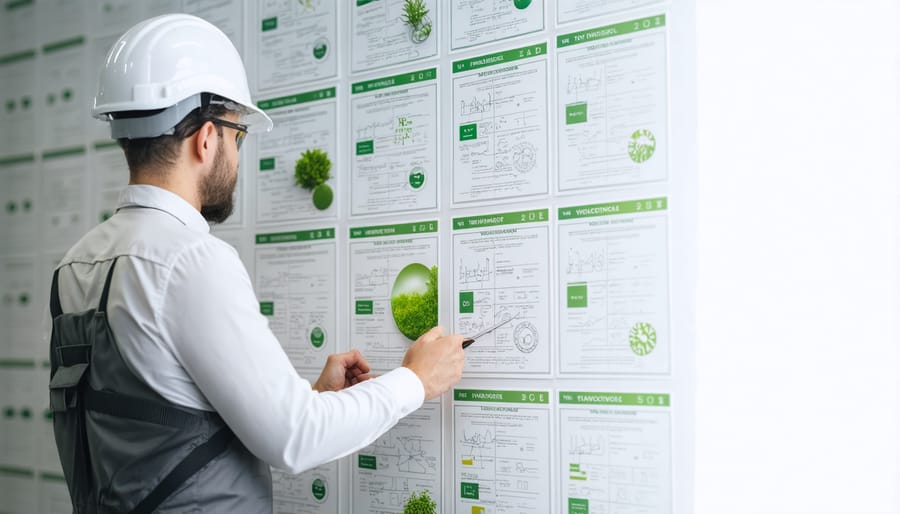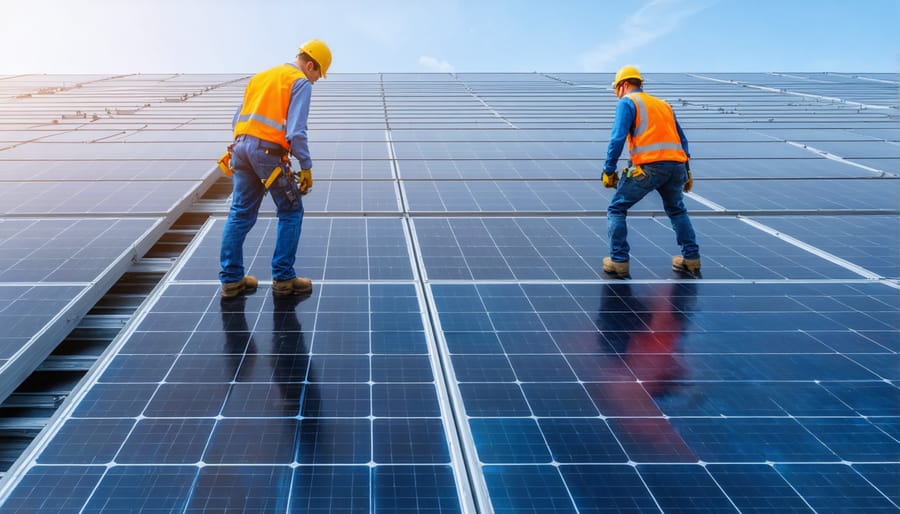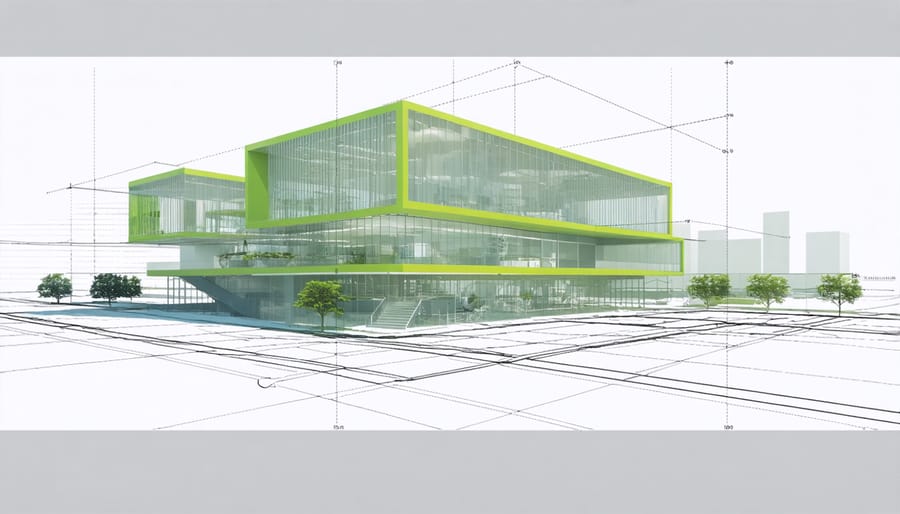In today’s rapidly evolving construction landscape, mastering green building skills isn’t just an environmental choice—it’s a powerful career advantage. Australia’s construction sector is undergoing a profound transformation, with sustainable building practices becoming the new standard rather than the exception. From innovative materials management to advanced energy-efficient systems, the skills required to excel in green construction combine traditional building expertise with cutting-edge sustainable technologies.
The demand for professionals who can seamlessly integrate environmental considerations into construction projects has never been higher. Whether it’s implementing passive solar design, managing waste reduction systems, or coordinating LEED certification processes, these specialized skills are reshaping how we approach building in the 21st century. As Australia commits to ambitious climate targets, the construction industry stands at the forefront of environmental innovation, creating unprecedented opportunities for those who develop expertise in sustainable building practices.
This strategic shift towards green construction requires a unique blend of technical knowledge, environmental awareness, and practical implementation skills. For builders, architects, and construction managers, understanding these core competencies isn’t just about meeting current regulations—it’s about leading the industry’s evolution towards a more sustainable future.
The Foundation of Green Building Excellence
Sustainable Materials Management
In modern green construction, mastering circular economy principles is essential for effective materials management. This involves selecting materials with minimal environmental impact, understanding their lifecycle, and implementing proper handling techniques to reduce waste.
Successful green builders prioritise locally sourced materials, recycled content, and products with environmental certifications. They’re skilled in identifying sustainable alternatives like bamboo flooring, recycled steel, and low-VOC finishes. Understanding sustainable resource management helps ensure materials are used efficiently throughout the construction process.
Key skills include proper material storage to prevent degradation, accurate quantity estimation to minimise waste, and knowledge of recycling and reuse protocols. Builders must also understand thermal properties of different materials, their durability in various climates, and their contribution to a building’s overall energy efficiency.
Australian construction professionals increasingly emphasise the importance of documentation and tracking of materials’ environmental credentials, ensuring compliance with green building standards while maintaining project sustainability goals.

Energy Efficiency Systems
Installing and maintaining energy-efficient building systems requires a unique blend of technical expertise and sustainable design knowledge. Professionals need to master the installation of smart HVAC systems, which includes understanding variable refrigerant flow systems and energy recovery ventilation. Proficiency in building automation systems (BAS) is essential for monitoring and optimizing energy consumption across different building zones.
Key skills include the ability to work with solar PV systems, including proper panel placement, inverter installation, and integration with building electrical systems. Understanding thermal insulation techniques and air-sealing methodologies is crucial for maintaining building envelope efficiency. Professionals should also be familiar with LED lighting systems, occupancy sensors, and daylight harvesting controls.
Water efficiency expertise is equally important, encompassing skills in installing low-flow fixtures, greywater systems, and smart irrigation controls. Knowledge of energy modelling software helps in predicting building performance and identifying optimization opportunities. Regular system maintenance and troubleshooting abilities ensure these technologies continue operating at peak efficiency.
Staying current with emerging technologies and energy efficiency standards is vital, as is the ability to communicate technical concepts to building owners and occupants.
Specialized Green Construction Techniques
Solar Integration Expertise
In today’s sustainable construction landscape, expertise in solar integration has become a cornerstone skill for green building professionals. Understanding how to effectively incorporate renewable energy systems into building designs requires a unique blend of technical knowledge and practical experience.
Key competencies include understanding solar panel specifications, optimal positioning for maximum energy capture, and integration with existing building systems. Professionals must master roof load calculations, structural requirements, and weatherproofing techniques specific to solar installations. Knowledge of electrical systems is crucial, particularly regarding inverter placement, wiring configurations, and connection to the main power supply.
Modern solar integration also demands familiarity with smart monitoring systems and energy storage solutions. Professionals should understand battery storage options, energy management systems, and how to optimize performance through strategic system design. Additionally, expertise in local building codes, safety regulations, and compliance requirements specific to solar installations is essential.
Digital literacy plays a vital role, as professionals must work with modeling software to simulate solar exposure, calculate energy yields, and design efficient systems. Understanding how to interpret solar resource data and perform cost-benefit analyses helps deliver optimal solutions for clients.
Practical experience with different mounting systems, connection methods, and maintenance requirements rounds out the skill set needed for successful solar integration in green building projects.

Water Conservation Systems
Water conservation systems are crucial components of sustainable building design, offering significant environmental benefits while reducing operational costs. In Australia’s often drought-prone climate, implementing these systems has become increasingly important for green construction professionals.
Rainwater harvesting stands out as a primary water conservation technique, involving the collection and storage of rainfall from rooftops in tanks for later use. Modern systems include first-flush diverters to ensure water quality and smart filtration technology for optimal performance. These systems can supply water for irrigation, toilet flushing, and even indoor use when properly treated.
Skilled green builders also focus on installing water-efficient fixtures and appliances, such as dual-flush toilets, low-flow taps, and water-smart washing machines. These installations require precise knowledge of current water efficiency standards and proper integration with existing plumbing systems.
Greywater recycling systems represent another vital skill area, allowing the reuse of water from sinks, showers, and laundries for garden irrigation or toilet flushing. Implementation requires understanding local regulations, appropriate treatment methods, and safe installation practices.
Smart irrigation systems with moisture sensors and weather-based controllers demonstrate the intersection of water conservation and modern technology. Professionals must master the programming and maintenance of these systems to ensure optimal water usage in landscaping applications.
For maximum effectiveness, water conservation systems should be integrated during the initial design phase, requiring collaboration between architects, plumbers, and sustainability consultants. Regular maintenance and monitoring ensure these systems continue to perform efficiently throughout the building’s lifecycle.
Digital Tools and Smart Building Technologies
Building Information Modeling (BIM)
Building Information Modeling has revolutionised sustainable construction by enabling teams to create detailed digital representations of buildings before breaking ground. This powerful tool allows professionals to analyse and optimise energy performance, material usage, and environmental impact throughout the project lifecycle.
In the Australian construction sector, BIM practitioners use sophisticated software to simulate building performance under various conditions. This includes studying natural lighting patterns, testing ventilation systems, and calculating energy consumption rates. These simulations help teams make informed decisions about sustainable design elements like solar panel placement, green roof integration, and passive cooling strategies.
BIM’s collaborative nature enables architects, engineers, and builders to identify potential sustainability challenges early, reducing waste and rework. For instance, clash detection features prevent costly mistakes that could compromise a building’s green credentials. The technology also supports accurate material quantity calculations, helping teams minimise waste and choose eco-friendly alternatives.
Modern BIM platforms integrate with environmental assessment tools, making it easier to achieve Green Star ratings and meet sustainability targets. As the industry evolves, proficiency in BIM has become essential for professionals committed to delivering environmentally responsible construction projects.

Energy Monitoring Systems
Modern energy monitoring systems are at the heart of green building performance, and mastering these technologies is crucial for sustainable construction professionals. The key skills include understanding building management systems (BMS), data analysis, and the integration of smart sensors throughout the building envelope.
Professionals need to be proficient in configuring and maintaining energy monitoring software platforms that track real-time consumption patterns. This involves setting up measurement and verification protocols, establishing baseline energy profiles, and implementing automated alert systems for unusual consumption patterns.
Essential competencies include interpreting energy usage data, creating performance reports, and recommending optimization strategies. Technicians should be familiar with various sensor types, their installation requirements, and troubleshooting procedures. Knowledge of wireless communication protocols and IoT integration is increasingly important as buildings become smarter.
Experience with Australian energy standards and rating systems like NABERS is vital. Professionals should also understand how to integrate renewable energy monitoring systems with traditional building controls, ensuring seamless operation between different energy sources and storage systems.
These skills enable practitioners to optimize building performance, reduce operational costs, and maintain compliance with sustainability requirements while ensuring occupant comfort.
Certification and Career Growth
Green Building Certifications
In Australia’s growing sustainable construction sector, several key certifications validate and enhance your green building expertise. The Green Star certification, developed by the Green Building Council of Australia (GBCA), stands as the industry benchmark for sustainable building practices. Professionals can become Green Star Accredited Professionals (GSAPs) through comprehensive training and assessment, demonstrating their ability to guide projects toward certification.
The NABERS (National Australian Built Environment Rating System) accreditation is another vital qualification, specifically focusing on building performance assessment. This certification enables professionals to measure and verify the environmental impact of buildings across energy, water, waste, and indoor environment categories.
International certifications like LEED (Leadership in Energy and Environmental Design) are increasingly recognised in Australia, offering global credibility and knowledge transfer opportunities. The Living Future Accreditation, though newer to the Australian market, is gaining traction for its rigorous focus on regenerative design principles.
For trades professionals, the Certificate IV in Building and Construction (Sustainable Building Practices) provides practical skills in implementing green building techniques. Additionally, specialised certifications in passive house design, renewable energy systems, and sustainable materials management are available through registered training organisations.
These certifications not only validate your expertise but also demonstrate your commitment to sustainable construction practices, making you more valuable to employers and clients in the green building sector.
Career Pathways
The green building sector offers diverse and rewarding career pathways for professionals committed to sustainable construction. As Australia’s construction industry embraces eco-friendly practices, opportunities continue to expand across various specializations. Entry-level positions often begin with roles such as green building technicians or sustainability coordinators, where professionals can gain hands-on experience while learning industry standards.
Mid-career professionals can advance to positions such as sustainable design consultants, LEED certification specialists, or energy efficiency managers. These roles combine technical expertise with project management skills, offering attractive sustainable investment opportunities and competitive salaries.
Senior-level positions include chief sustainability officers, green building project directors, and environmental compliance managers. These roles often involve strategic planning, team leadership, and collaboration with stakeholders across the construction ecosystem. The demand for experienced professionals in these positions continues to grow as more organizations prioritize sustainable building practices.
Entrepreneurial opportunities also abound, with many professionals establishing consulting firms specializing in green building certifications, sustainable materials sourcing, or renewable energy integration. The sector’s growth has created niches for specialized services, from energy auditing to waste management optimization.
For career advancement, maintaining current certifications and staying informed about emerging technologies and practices is essential. Industry networking, continuous professional development, and practical experience in sustainable projects are key factors in building a successful career in green construction.
The journey towards sustainable construction in Australia represents more than just a shift in building practices – it’s a fundamental transformation of our industry and our future. As we’ve explored throughout this article, developing green building skills is no longer optional but essential for construction professionals who want to remain competitive and contribute to a more sustainable tomorrow.
The impact of these skills extends far beyond individual career prospects. By embracing sustainable construction practices, we’re helping to reduce Australia’s carbon footprint, create healthier living and working environments, and build resilient communities that can withstand future environmental challenges. The growing demand for green buildings has created exciting opportunities for those who possess these specialized skills, from energy efficiency specialists to sustainable materials experts.
Looking ahead, the construction industry’s role in achieving Australia’s climate goals cannot be understated. Every sustainable building project, every energy-efficient renovation, and every green innovation brings us closer to our national environmental targets. The skills we develop today will shape the cities and communities of tomorrow.
For those considering a career in construction or looking to upgrade their existing skill set, the message is clear: green building skills are your passport to a promising and purposeful future. By investing in these capabilities now, you’re not just future-proofing your career – you’re becoming part of the solution to one of our generation’s greatest challenges. Together, we can build a greener, more sustainable Australia, one project at a time.

